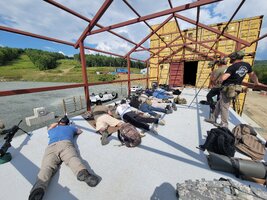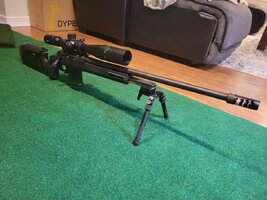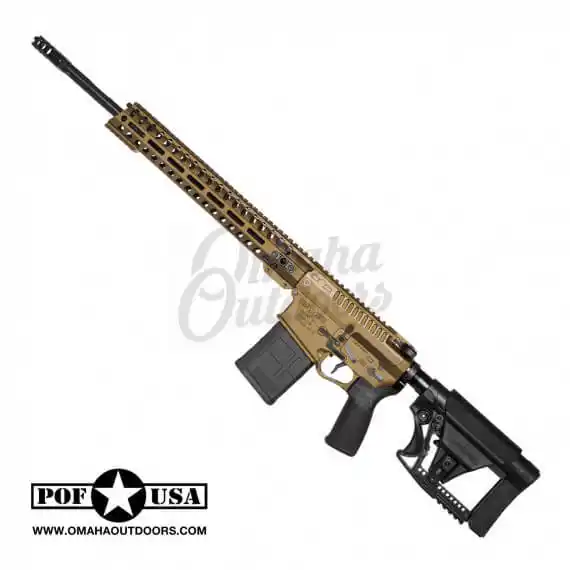F2386
NES Member
Hey all, I've seen a couple Ridgeline reviews but not one on their Precision Rifle class. My buddy and I just completed the 2 day course so here's my overview for those who wanted some first hand experience.
About me - I'm a recreational shooter who gets out maybe once or twice a year. I'd love to do more but work and a young family means time is limited. I did not have a long range rifle prior to signing up for this class and the longest range I ever shot was 200 yards.
My equipment - I ran the course with the following: A Bergara B-14 BMP 24" with a KRG Bravo chassis, chambered in 6.5 creedmoor, full length ARCA rail plus an extended spigot, an Atlas BT65, a Vortex PST gen 2 5-25x50 MRAD FFP and Hornady 140gr ELD-M.
The class - This is a 16-hour course spanning two days.
The description from Ridgeline -
Precision Rifle is designed to provide the student with a systematic approach to precision rifle marksmanship, manipulations, and employment. Our curriculum is progressive in format, with each component skill laying the foundation for the next and creating a well-rounded precision rifle shooter.
Students will engage in multiple repetitions as they hone skills like properly zeroing and data collection, ballistic theory, wind theory, and decreasing engagement times. These skill learnings will be amplified by the ability to utilize not just paper targets but multiple steel target arrays and challenging drills provided by the cadre as students shoot out to 600 yards.
Subjects Covered :
-Equipment selection
-How to properly set up a precision rifle
-Fundamentals of rifle marksmanship
-The zeroing process
-An introduction to ballistic theory
-Data collection/Validation from 100-600 yards
-Wind theory and application
-How to develop a firing solution
-How to decrease engagement time
My experience - The facility is located in Dalton, NH so my friend and I rented an Airbnb in Lincoln which was about 35 minutes away. This got us close to class, which started at 9AM sharp, and gave us access to bars, restaurants and etc so we had something to do off-hours.
We arrived at the facility with with five minutes to spare. There are multiple shooting pits, multi-level shooting structures, barricades/vehicles, a 100 yard flat range, three longer distance ranges that go from 200 to 600 yards (they mark them A, B and C - C being known distances). We shot 50% from the 100 yard flat range and 50% from a "snipers nest" into the A/B/C ranges (see image below). Our instructors were Jay, who is a member here @Jay P, and Larry. Both of whom are way over qualified teaching a beginner's precision rifle class. Regardless, they're great guys who took the time to work with students who needed extra attention. Whether it was equipment related or skills related, it felt like Jay and Larry were always there to help us through issues and get us through the process.
The initial class started in an air-conditioned trailer right beside the parking lot. They're almost done with a much nicer permanent building where I assume classes will be held in the future. It felt like 90 minutes of PowerPoints on the listed subjects through the zeroing process. We finally hit the range and spent a good portion of time printing on paper getting a 100 yard zero. My patterns weren't great with only one grouping being sub MOA. Others in the class had much tighter groups. Before we broke for a 45 minute lunch, they chrono'd our rifles and we measured our bore over sight. Bring your lunch because the closest town was almost 15 mins away.
Class resumed with ballistic theory. They had us all download GeoBallistics onto our phones. We walked through the calculator and it eventually spat out our individual ballistic data. We had more classroom instruction on ballistics and the associated variables that affect us at long range.
We got back out onto the 100 yd flat range to reconfirm zero then we all hopped onto the sniper's nest to shoot steel targets at known ranges from 200 to 600 using our newly acquired ballistic data. Most, if not all, of us were able to confirm that our data was dead on accurate. We ended the first day doing some fun drills shooting down C range.
The second day started off in the classroom talking about wind theory and wind calling. We hit the flat range to confirm zero, we patterned our rifles again and we did some timed drills that started off easy and got harder and harder as they cut the par time down. By the end of some of the drills, no one was completing the tasks. An example of one of the drills - start standing at low ready with your bipod up and rear bag in hand, at the beep drop to your shooting position and accurately shoot one round then reload and shoot another round. By the end of the exercise we had to complete this in under 20 seconds, which sounds easy but was far from that.
We hit the sniper's nest again and started working on C range hitting known distances and talking about range estimation. After lunch, we talked more about range estimation, how to come up with a firing solution in a timely manner, shortcuts you can take and etc. The last part of the class involved a series of fun drills shooting unknown ranges A and B. We ended the class with a fun exercise where each student had to test their skills acquired over the last two days.
I don't want to ruin the surprise but the competition was timed and it required us to run into an unknown structure, set up into a shooting position, scan and identify targets, develop a firing solution and engage. The winner walks away with a prize they reserve only for instructors and the winner of each competition they hold at the end of every class. I don't remember my time but I won it by one second.
My overall impression and last thoughts - If you were thinking about doing this class, absolutely take it. You'll quickly develop the confidence to shoot out to long distances. 600 yards seemed long at first but by the end I would have loved the chance to shoot to 1200. This was time and money well spent and I'm definitely taking the next course.
Out of 12 students, 3 of us shot 6.5 CM, 1 shot 5.56mm, and the rest were 308 win. 10 were bolt rifles and 2 were AR pattern rifles. 6.5 CM excelled notably, especially at 600 yards and with slight wind. You'll learn about this but 308 win goes trans sonic around 800 yards so it seemed to be affected by wind and bullet drop more than 6.5 CM. Mine went trans sonic around 1200 yards. Most people ran MIL reticles over MOA. MIL is highly recommended.
The class had varying degrees of experience. Some students required a lot more attention than others. You'll need to be patient because you might wait a bit doing drills. If your class has a good rhythm then it will be more seamless. We did a lot of waiting unfortunately. I'll add that I'm not the best shooter and this is my first class. This experience wasn't intimidating at all and it's really meant for everyone.
We're outside in the prone position a lot. As a result, we baked in 80 to 85 degree sunny weather most of the time. Wear sunscreen and drink a ton of water. Wear a hat and pants.
Lastly, Ridgeline is a small but highly experienced group of instructors. They don't spend any resources marketing so they asked us to spread the word. They're great guys who we should support. Let's help them out if you can make the trip.


About me - I'm a recreational shooter who gets out maybe once or twice a year. I'd love to do more but work and a young family means time is limited. I did not have a long range rifle prior to signing up for this class and the longest range I ever shot was 200 yards.
My equipment - I ran the course with the following: A Bergara B-14 BMP 24" with a KRG Bravo chassis, chambered in 6.5 creedmoor, full length ARCA rail plus an extended spigot, an Atlas BT65, a Vortex PST gen 2 5-25x50 MRAD FFP and Hornady 140gr ELD-M.
The class - This is a 16-hour course spanning two days.
The description from Ridgeline -
Precision Rifle is designed to provide the student with a systematic approach to precision rifle marksmanship, manipulations, and employment. Our curriculum is progressive in format, with each component skill laying the foundation for the next and creating a well-rounded precision rifle shooter.
Students will engage in multiple repetitions as they hone skills like properly zeroing and data collection, ballistic theory, wind theory, and decreasing engagement times. These skill learnings will be amplified by the ability to utilize not just paper targets but multiple steel target arrays and challenging drills provided by the cadre as students shoot out to 600 yards.
Subjects Covered :
-Equipment selection
-How to properly set up a precision rifle
-Fundamentals of rifle marksmanship
-The zeroing process
-An introduction to ballistic theory
-Data collection/Validation from 100-600 yards
-Wind theory and application
-How to develop a firing solution
-How to decrease engagement time
My experience - The facility is located in Dalton, NH so my friend and I rented an Airbnb in Lincoln which was about 35 minutes away. This got us close to class, which started at 9AM sharp, and gave us access to bars, restaurants and etc so we had something to do off-hours.
We arrived at the facility with with five minutes to spare. There are multiple shooting pits, multi-level shooting structures, barricades/vehicles, a 100 yard flat range, three longer distance ranges that go from 200 to 600 yards (they mark them A, B and C - C being known distances). We shot 50% from the 100 yard flat range and 50% from a "snipers nest" into the A/B/C ranges (see image below). Our instructors were Jay, who is a member here @Jay P, and Larry. Both of whom are way over qualified teaching a beginner's precision rifle class. Regardless, they're great guys who took the time to work with students who needed extra attention. Whether it was equipment related or skills related, it felt like Jay and Larry were always there to help us through issues and get us through the process.
The initial class started in an air-conditioned trailer right beside the parking lot. They're almost done with a much nicer permanent building where I assume classes will be held in the future. It felt like 90 minutes of PowerPoints on the listed subjects through the zeroing process. We finally hit the range and spent a good portion of time printing on paper getting a 100 yard zero. My patterns weren't great with only one grouping being sub MOA. Others in the class had much tighter groups. Before we broke for a 45 minute lunch, they chrono'd our rifles and we measured our bore over sight. Bring your lunch because the closest town was almost 15 mins away.
Class resumed with ballistic theory. They had us all download GeoBallistics onto our phones. We walked through the calculator and it eventually spat out our individual ballistic data. We had more classroom instruction on ballistics and the associated variables that affect us at long range.
We got back out onto the 100 yd flat range to reconfirm zero then we all hopped onto the sniper's nest to shoot steel targets at known ranges from 200 to 600 using our newly acquired ballistic data. Most, if not all, of us were able to confirm that our data was dead on accurate. We ended the first day doing some fun drills shooting down C range.
The second day started off in the classroom talking about wind theory and wind calling. We hit the flat range to confirm zero, we patterned our rifles again and we did some timed drills that started off easy and got harder and harder as they cut the par time down. By the end of some of the drills, no one was completing the tasks. An example of one of the drills - start standing at low ready with your bipod up and rear bag in hand, at the beep drop to your shooting position and accurately shoot one round then reload and shoot another round. By the end of the exercise we had to complete this in under 20 seconds, which sounds easy but was far from that.
We hit the sniper's nest again and started working on C range hitting known distances and talking about range estimation. After lunch, we talked more about range estimation, how to come up with a firing solution in a timely manner, shortcuts you can take and etc. The last part of the class involved a series of fun drills shooting unknown ranges A and B. We ended the class with a fun exercise where each student had to test their skills acquired over the last two days.
I don't want to ruin the surprise but the competition was timed and it required us to run into an unknown structure, set up into a shooting position, scan and identify targets, develop a firing solution and engage. The winner walks away with a prize they reserve only for instructors and the winner of each competition they hold at the end of every class. I don't remember my time but I won it by one second.
My overall impression and last thoughts - If you were thinking about doing this class, absolutely take it. You'll quickly develop the confidence to shoot out to long distances. 600 yards seemed long at first but by the end I would have loved the chance to shoot to 1200. This was time and money well spent and I'm definitely taking the next course.
Out of 12 students, 3 of us shot 6.5 CM, 1 shot 5.56mm, and the rest were 308 win. 10 were bolt rifles and 2 were AR pattern rifles. 6.5 CM excelled notably, especially at 600 yards and with slight wind. You'll learn about this but 308 win goes trans sonic around 800 yards so it seemed to be affected by wind and bullet drop more than 6.5 CM. Mine went trans sonic around 1200 yards. Most people ran MIL reticles over MOA. MIL is highly recommended.
The class had varying degrees of experience. Some students required a lot more attention than others. You'll need to be patient because you might wait a bit doing drills. If your class has a good rhythm then it will be more seamless. We did a lot of waiting unfortunately. I'll add that I'm not the best shooter and this is my first class. This experience wasn't intimidating at all and it's really meant for everyone.
We're outside in the prone position a lot. As a result, we baked in 80 to 85 degree sunny weather most of the time. Wear sunscreen and drink a ton of water. Wear a hat and pants.
Lastly, Ridgeline is a small but highly experienced group of instructors. They don't spend any resources marketing so they asked us to spread the word. They're great guys who we should support. Let's help them out if you can make the trip.



![Bang Head [banghead] [banghead]](/xen/styles/default/xenforo/smilies.vb/045.gif)

![Smile [smile] [smile]](/xen/styles/default/xenforo/smilies.vb/001.gif)